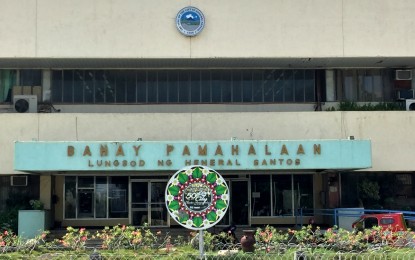
The City Hall building of General Santos City. (PNA GenSan file photo)
GENERAL SANTOS CITY – The city government may need to revisit its drainage plan and set remedial measures after the area experienced Tuesday evening one of the worst floods in recent years that affected at least 12 barangays.
Dr. Agripino Dacera Jr., head of the City Disaster Risk Reduction and Management Office, acknowledged Thursday that the city’s drainage system might require some modifications to cope with the expanding local developments.
Dacera cited the “sprouting” of housing subdivisions that further increased the area’s migration rate in the past several years.
“This is a growing city and a growing city also increases demand for services of government,” Dacera said in an interview over local television program “Morning Hataw”.
The review would help the local government improve its capacity to prevent the occurrence of more severe floods, especially in the low-lying areas, he said.
Over 140 families in parts of the city were temporarily displaced early Wednesday while a number of houses and other structures were damaged due to heavy flooding, which came following hours of continuous rains that started Tuesday evening.
A report released by the CDRRMO as of 6 p.m. Wednesday said some of the affected residents remained in the evacuation centers as floodwaters have yet to subside in several areas.
It said the floods were caused by the continuous heavy rains for over five hours that resulted in the accumulation of a huge volume of runoff water coming from various barangays.
“The said runoff flowed down to the lower portions and caused flooding that damaged properties and lifeline facilities,” the report said.
Dacera said they also monitored heavy water runoff from the watershed areas in the city’s boundaries with South Cotabato and Sarangani provinces.
He said the flooding was worsened by the clogged drainage canals, especially the smaller or secondary to tertiary waterways, due to the accumulation of household wastes and other debris.
Aside from the review of the drainage plan, Dacera said there is a need to look into the existing city ordinances and policies, especially on waste management and disposal.
“We might need to enhance our social mobilization on proper waste disposal or increase collection services. These are engagements that need the cooperation of both government and community stakeholders,” he said. (PNA)
